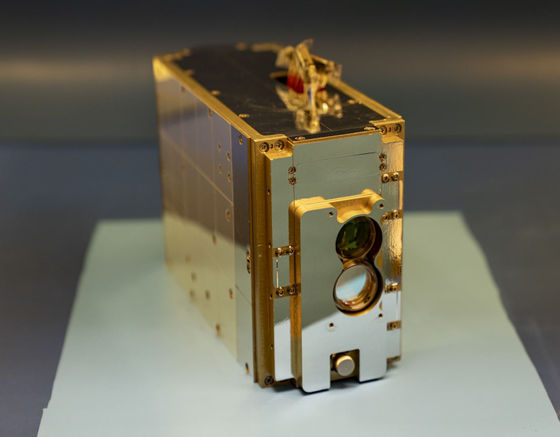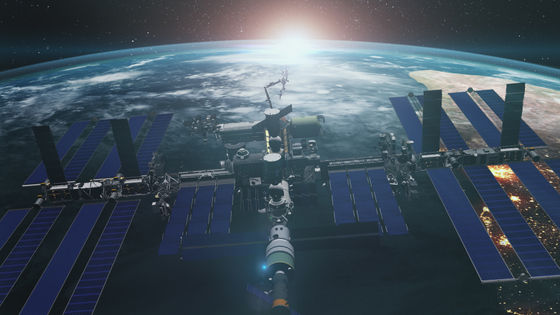Laser communication from space to the ground achieved 200 gigabits per second and established a new record, capable of transferring 2 terabytes equivalent to 1000 movies in 5 minutes

The satellite communication system `` TeraByte InfraRed Delivery (TBIRD) '' jointly developed by NASA and the Massachusetts Institute of Technology (MIT) recorded a transfer rate of 200 Gbps, doubling the 100 Gbps record achieved in 2022. I understand. A low-cost, small, and high-speed satellite laser communication system has made it possible to instantaneously transmit vast amounts of data acquired by satellites to the ground, and it is hoped that scientific missions observing the universe will bring further discoveries. increase.
NASA, Partners Achieve Fastest Space-to-Ground Laser Comms Link | NASA
NASA's Laser Link Boosts Record-Breaking 200-Gb/s Speed - IEEE Spectrum
https://spectrum.ieee.org/laser-communications
On May 12, 2023, NASA announced that a satellite-to-ground laser communication test conducted in April achieved a throughput of 200 Gbps, the highest data transfer rate ever. As a result, the satellite can send more than 2 TB of data, which is equivalent to 1000 high-definition movies, just by passing over the ground station for 5 minutes.

“It makes a lot of sense because more data means more discoveries,” said Jason Mitchell, an aerospace engineer for NASA's Space Communications and Navigation Program.
The TBIRD system that enables this laser communication will be installed on NASA's Pathfinder Technology Demonstration Satellite-3 (PTD-3) and will be put into orbit by SpaceX's satellite rideshare mission 'Transporter-5' in May 2022. You got me. The PTD-3 satellite, orbiting at an altitude of about 530 km, is

by
In general, high-speed communication on the earth is done by laser communication using optical fiber, but there is still no artificial satellite that can perform high-speed Internet communication with laser. Therefore, space agencies and space development companies are using radio for communication in outer space, and as satellites become more sophisticated, the slowness of radio communication is becoming an issue.
Since the infrared rays used for laser communication have a higher frequency than radio waves, faster data communication is possible, but the development of TBIRD and the achievement of this record were not easy.
For example, many of the components developed for terrestrial laser communications were not designed to withstand the harsh environments of rocket launches and outer space. As a result, when we conducted tests assuming operation in space, the cable of the optical signal amplifier sometimes melted. The reason for this was that the amplifier, which was made on the premise of dissipating heat by air convection, could not dissipate heat well in a vacuum. Therefore, the research team worked with amplifier manufacturers to improve cooling by thermal conduction.

Also, lasers reaching the ground from space are distorted by atmospheric influences and weather conditions, resulting in data loss. To address this problem, scientists independently developed ARQ (Automatic Repeat Request), a protocol for correcting errors that occur during data transmission. This mechanism, in which the ground station tells the satellite which data blocks (frames) have been received correctly, allows the satellite to identify which frames should be retransmitted, thus eliminating unnecessary data retransmission time. It is now possible.
In addition, there was also the problem that laser beams are narrower than wireless communication. Because of this, the beam must be precisely aimed at the receiver, so the laser device is typically mounted on a gimbal , or rotating platform. However, since TBIRD is mounted on a small CubeSat, a bulky swivel cannot be used. So the research team solved it by using the error signal to correct the orientation of the satellite. This gimbal-less strategy has led to further miniaturization of TBIRD and has also contributed to the reduction of launch costs.
After reaching the 200 Gbps milestone, the next goal for the research team is to find a suitable scientific mission for this technology. 'This technique is well suited for scientific missions that benefit greatly from collecting a lot of data,' says Kat Riesing, an aerospace engineer who works at MIT Lincoln Laboratory. We can think of exciting activities in the 'Event Horizon Explorer Mission' that expands the scope .'
At the Event Horizon Telescope, which succeeded in imaging a black hole for the first time, each telescope that participated in the observation produced a huge amount of data of 350 TB per day. In the future, when artificial satellites such as space telescopes participate in such missions, high-speed communication between space and the ground will be essential.
Succeeded in the first ever ``imaging of a black hole'', existing in the galaxy M87 55 million light years from the earth with a mass 6.5 billion times that of the sun - GIGAZINE

According to Liesing, the research team is also exploring ways to use TBIRD in future lunar missions. The communication speed under consideration is 1 to 5 Gbps, which seems unimpressive compared to 200 Gbps, but it is an amazing speed considering the distance between the moon and the earth is about 400,000 km.
This technology may also be applied to data links on Earth. ``It could be useful in places where people can't easily reach, for example, building to building, mountaintop to mountaintop, where the cost of laying fiber is prohibitive,'' Liesing said. bottom.
Related Posts:
in Science, Posted by log1l_ks







